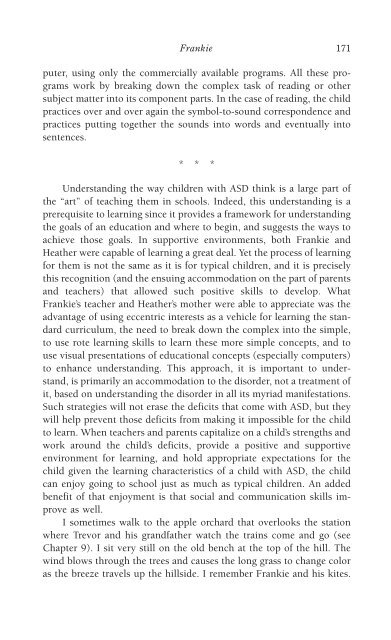978-1572305441
autism
autism
You also want an ePaper? Increase the reach of your titles
YUMPU automatically turns print PDFs into web optimized ePapers that Google loves.
Frankie 171<br />
puter, using only the commercially available programs. All these programs<br />
work by breaking down the complex task of reading or other<br />
subject matter into its component parts. In the case of reading, the child<br />
practices over and over again the symbol-to-sound correspondence and<br />
practices putting together the sounds into words and eventually into<br />
sentences.<br />
* * *<br />
Understanding the way children with ASD think is a large part of<br />
the “art” of teaching them in schools. Indeed, this understanding is a<br />
prerequisite to learning since it provides a framework for understanding<br />
the goals of an education and where to begin, and suggests the ways to<br />
achieve those goals. In supportive environments, both Frankie and<br />
Heather were capable of learning a great deal. Yet the process of learning<br />
for them is not the same as it is for typical children, and it is precisely<br />
this recognition (and the ensuing accommodation on the part of parents<br />
and teachers) that allowed such positive skills to develop. What<br />
Frankie’s teacher and Heather’s mother were able to appreciate was the<br />
advantage of using eccentric interests as a vehicle for learning the standard<br />
curriculum, the need to break down the complex into the simple,<br />
to use rote learning skills to learn these more simple concepts, and to<br />
use visual presentations of educational concepts (especially computers)<br />
to enhance understanding. This approach, it is important to understand,<br />
is primarily an accommodation to the disorder, not a treatment of<br />
it, based on understanding the disorder in all its myriad manifestations.<br />
Such strategies will not erase the deficits that come with ASD, but they<br />
will help prevent those deficits from making it impossible for the child<br />
to learn. When teachers and parents capitalize on a child’s strengths and<br />
work around the child’s deficits, provide a positive and supportive<br />
environment for learning, and hold appropriate expectations for the<br />
child given the learning characteristics of a child with ASD, the child<br />
can enjoy going to school just as much as typical children. An added<br />
benefit of that enjoyment is that social and communication skills improve<br />
as well.<br />
I sometimes walk to the apple orchard that overlooks the station<br />
where Trevor and his grandfather watch the trains come and go (see<br />
Chapter 9). I sit very still on the old bench at the top of the hill. The<br />
wind blows through the trees and causes the long grass to change color<br />
as the breeze travels up the hillside. I remember Frankie and his kites.



